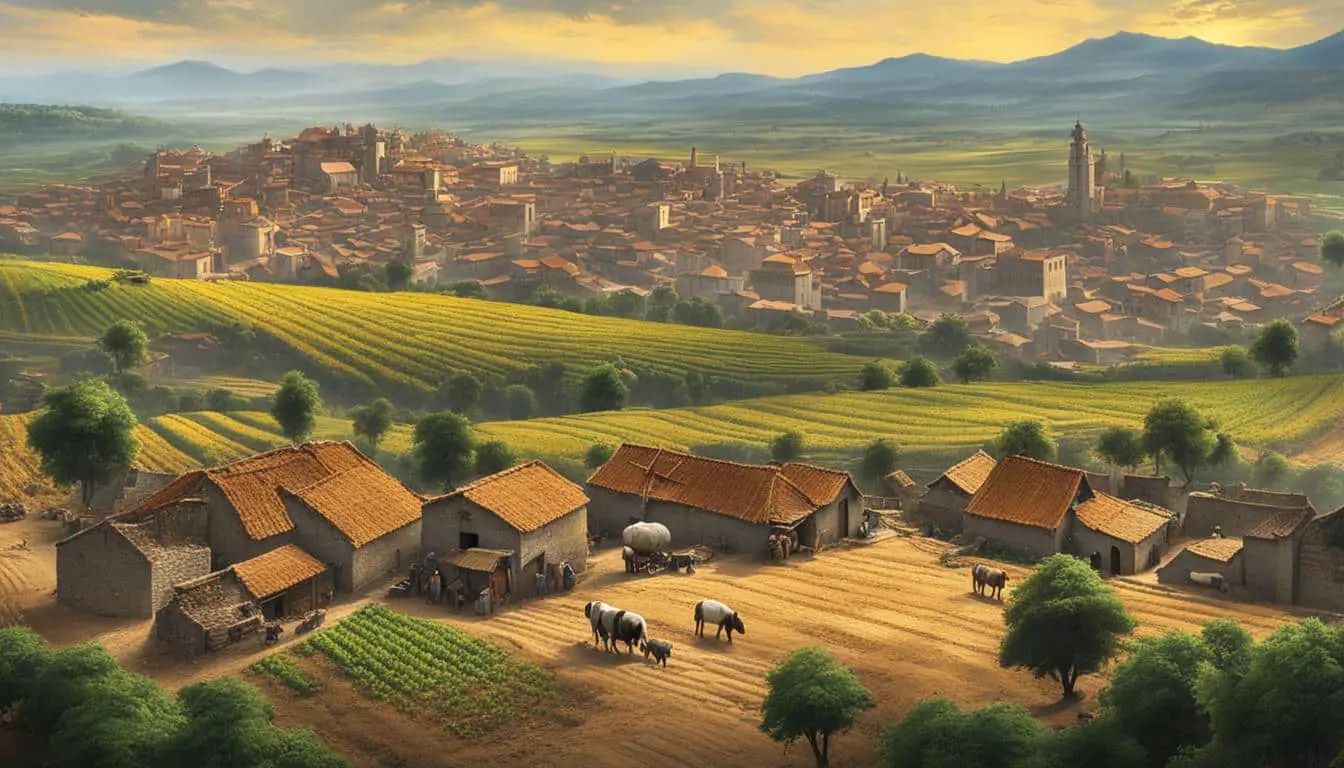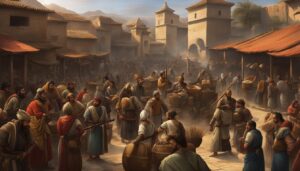
In ancient biblical times, the differences between urban and rural life were profound. The socio-economic and cultural dynamics of the era shaped the distinct lifestyles experienced by urban and rural dwellers. Let’s delve into the disparities and similarities between urban and rural living during this period.
Key Takeaways:
- The majority of people in ancient biblical times lived close to or below the subsistence level, with poverty being prevalent.
- Urban areas were characterized by an elite class enjoying privileges and wealth, while rural areas relied on agriculture for sustenance.
- The Roman Empire’s social and economic policies perpetuated inequality, with the extraction of agricultural surpluses benefiting the cities.
- Urbanization led to hierarchical social structures in cities, while rural areas maintained a focus on agricultural communities.
- Despite differences, both urban and rural communities were part of the same socio-political and economic system, sharing religious practices and reliance on agriculture.
Social Dynamics in Urban and Rural Biblical Societies
The social dynamics in urban and rural biblical societies were shaped by the differences in their economic structures and cultural norms. Urbanization in ancient biblical times led to the growth of cities with large populations, while the majority of the people lived in villages and engaged in agricultural practices. Cities had a hierarchical social structure, with rulers, the governing class, and the urban elite enjoying privileges and wealth. The majority of the population in cities consisted of peasants, who had little control over their political and economic situations. In rural areas, the social structure was centered around agricultural communities, with peasants working the land owned by the elite families.
There were clear distinctions in the social status and opportunities between urban and rural residents in biblical times. Urbanization created a divide between the rich and the poor, with the cities serving as centers of power and commerce, while the villages mainly provided agricultural surpluses to sustain the cities. The urban lifestyle offered greater opportunities for social mobility, access to education, and a wider range of occupations, while the rural lifestyle was characterized by a close-knit community, reliance on agricultural work, and limited social and economic opportunities.
Despite these differences, both urban and rural communities were part of the same socio-political and economic system governed by the Roman Empire. Both relied on agriculture as the primary means of sustenance, with the rural areas providing agricultural surpluses to support the cities. In terms of religious practices, both urban and rural residents participated in cultic services, with the priests playing a significant role in both settings. However, the urban communities had more access to cultural amenities and services, while the rural areas were primarily focused on agricultural production.

Table: Comparative Analysis of Urban and Rural Societies in Biblical Times
| Aspects | Urban Biblical Societies | Rural Biblical Societies |
|---|---|---|
| Social Structure | Hierarchical with urban elite and ruling class | Community-based with peasants and elite landowners |
| Economic Opportunities | Wide range of occupations and access to education | Reliance on agricultural work with limited opportunities |
| Access to Services | Cultural amenities and services | Primarily focused on agricultural production |
| Religious Practices | Participation in cultic services | Participation in cultic services |
The contrasts between urban and rural life in biblical times were a reflection of the socio-economic and cultural dynamics of the ancient world. The urban centers acted as hubs of power, commerce, and cultural activities, while the rural areas sustained these urban centers through agricultural production. Despite the differences, both urban and rural communities played integral roles in the overall functioning of the biblical societies, each contributing in their own unique ways.
Similarities and Contrasts Between Urban and Rural Biblical Life
When examining urban and rural life in biblical times, it is important to acknowledge the significant differences that existed between these two spheres. However, it is equally important to recognize the areas of overlap and similarities that also existed.
Both urban and rural communities formed integral parts of the social fabric in ancient times, contributing to the larger socio-political and economic system governed by the Roman Empire. Agriculture served as the primary means of sustenance for both urban and rural dwellers, with the rural areas supplying much-needed agricultural surpluses to support the cities.
Religious practices were another area of convergence. In both urban and rural settings, cultic services were an important aspect of daily life, with the role of priests being significant in both contexts. However, it is worth noting that urban communities often had greater access to cultural amenities and services, while rural areas were primarily focused on agricultural production.
Despite these similarities, there were clear contrasts between urban and rural life in biblical times. The urban lifestyle allowed for greater social mobility, access to education, and a wider range of occupational opportunities. On the other hand, the rural lifestyle was characterized by a close-knit community, reliance on agricultural work, and limited social and economic prospects.
Overall, the similarities and contrasts between urban and rural life in biblical times were a reflection of the socio-economic and cultural dynamics of the ancient world. Understanding these nuances helps us gain a deeper appreciation of the complexities and intricacies of life during that time.
FAQ
What were the differences in lifestyle between urban and rural communities in biblical times?
In biblical times, urban communities had a hierarchical social structure, with a privileged urban elite enjoying wealth and privileges. The majority of the population in cities were peasants who had limited control over their political and economic situations. In contrast, rural communities focused on agricultural practices and were centered around agricultural communities, with peasants working the land owned by elite families.
How did social dynamics differ between urban and rural biblical societies?
Urbanization in ancient biblical times led to the growth of large cities, with rulers, the governing class, and the urban elite enjoying privileges and wealth. In contrast, the social structure in rural areas was centered around agricultural communities, with peasants working the land. There were clear distinctions in social status and opportunities between urban and rural residents in biblical times, with cities serving as centers of power and commerce.
What were the similarities and overlaps between urban and rural life in biblical times?
Both urban and rural communities were part of the same socio-political and economic system governed by the Roman Empire. Both relied on agriculture as the primary means of sustenance, with rural areas providing agricultural surpluses to support the cities. In terms of religious practices, both urban and rural residents participated in cultic services, with priests playing a significant role in both settings.
What were the main contrasts between urban and rural life in biblical times?
The main contrasts between urban and rural life in biblical times revolved around social status, economic opportunities, and living conditions. Urban residents had greater opportunities for social mobility, access to education, and a wider range of occupations. In contrast, the rural lifestyle was characterized by a close-knit community, reliance on agricultural work, and limited social and economic opportunities.








